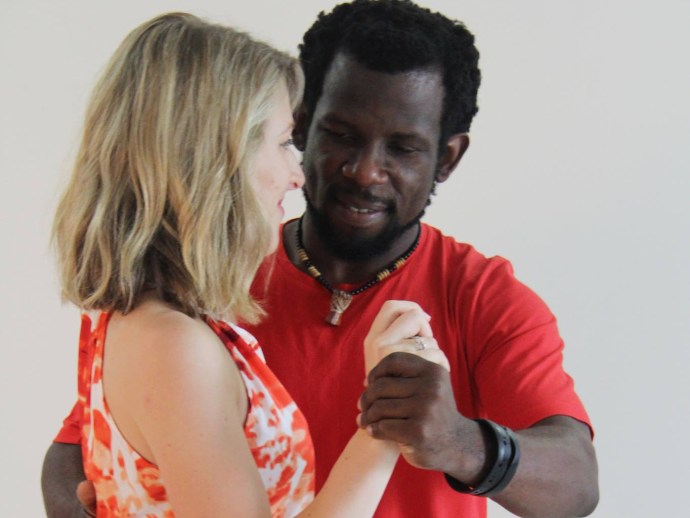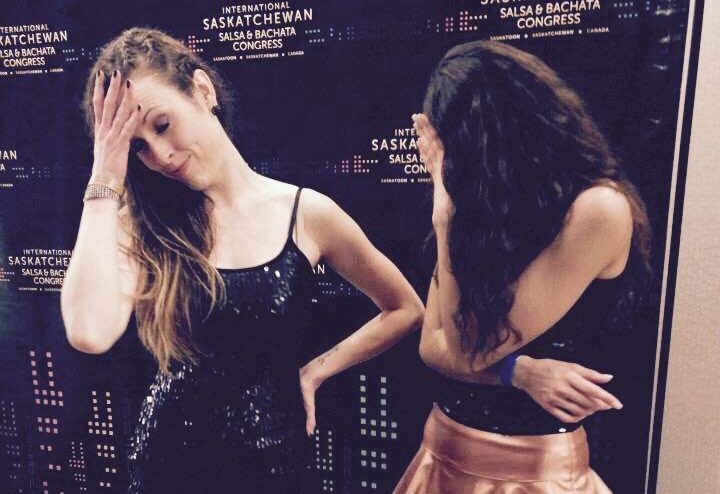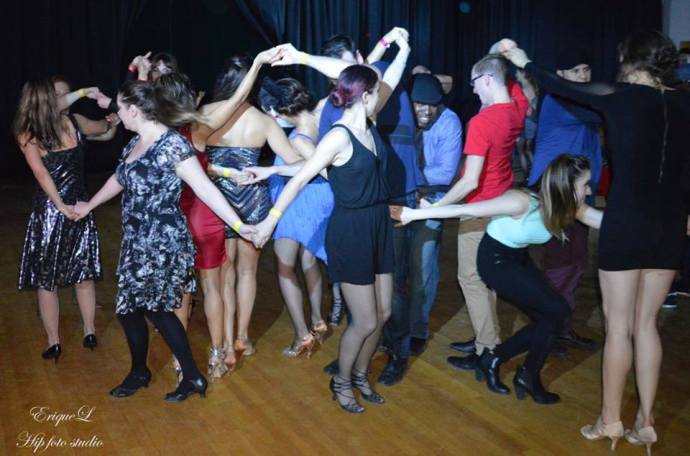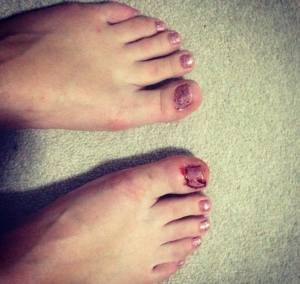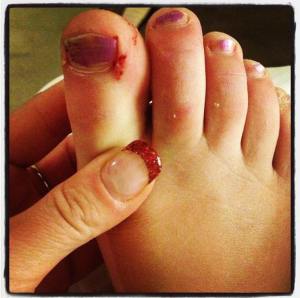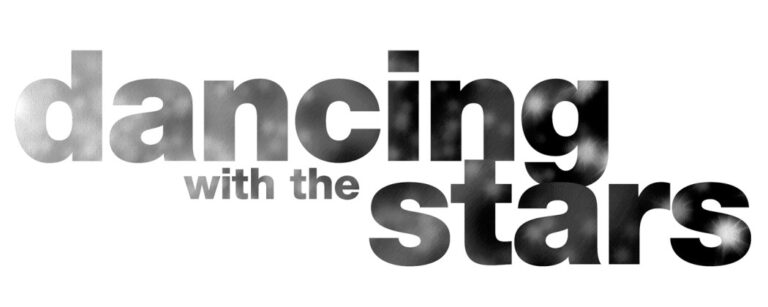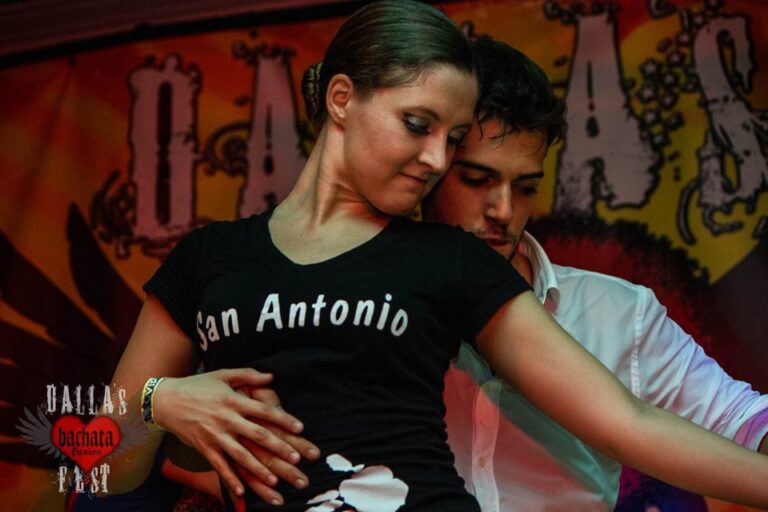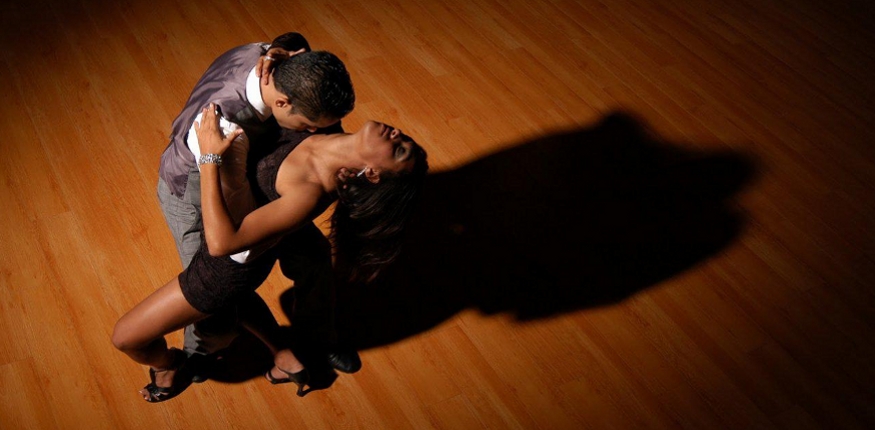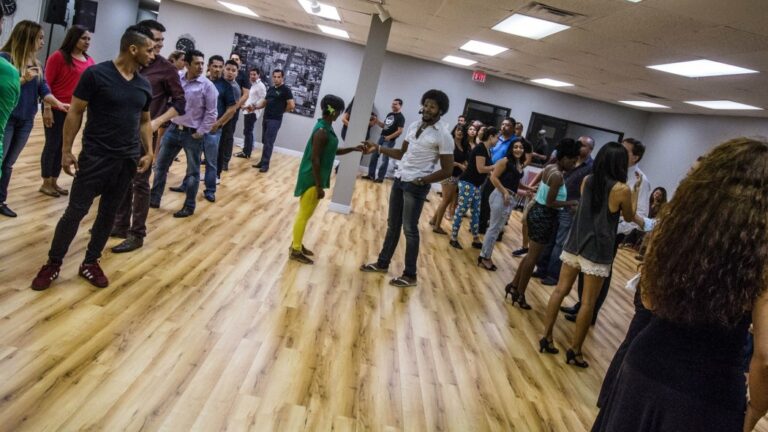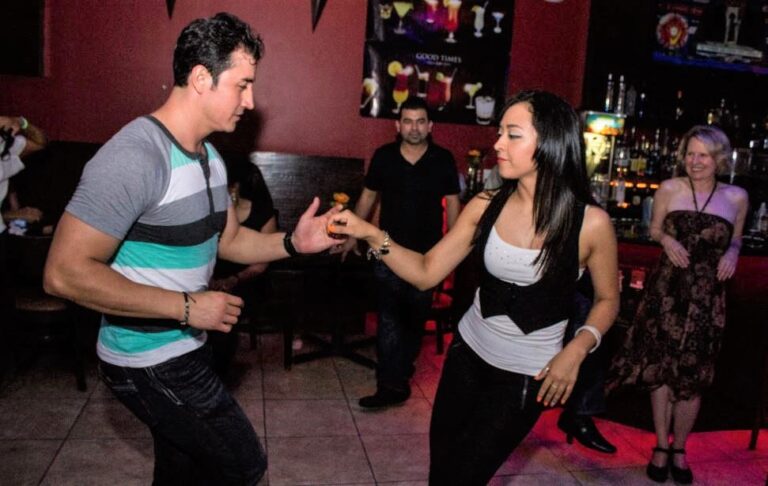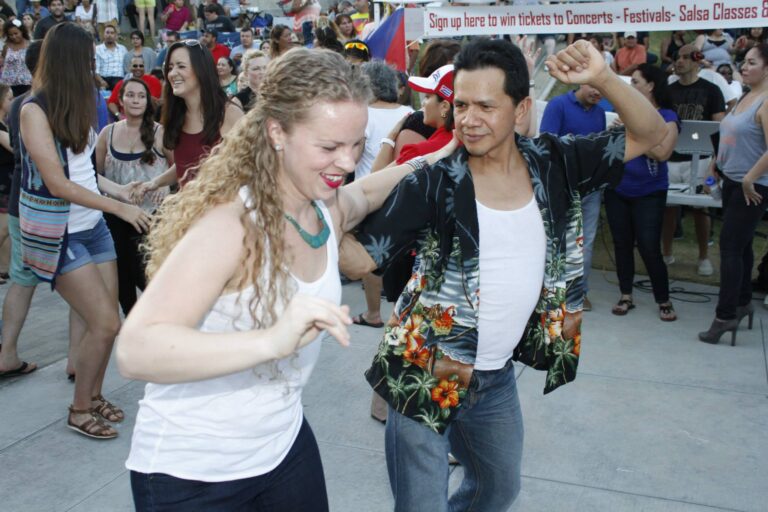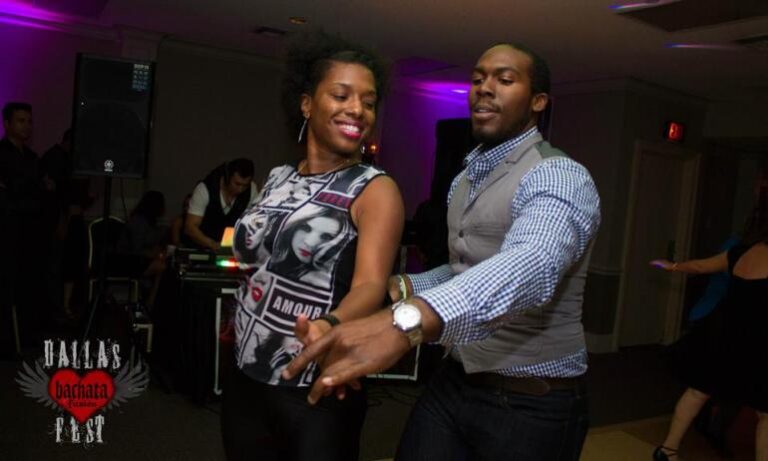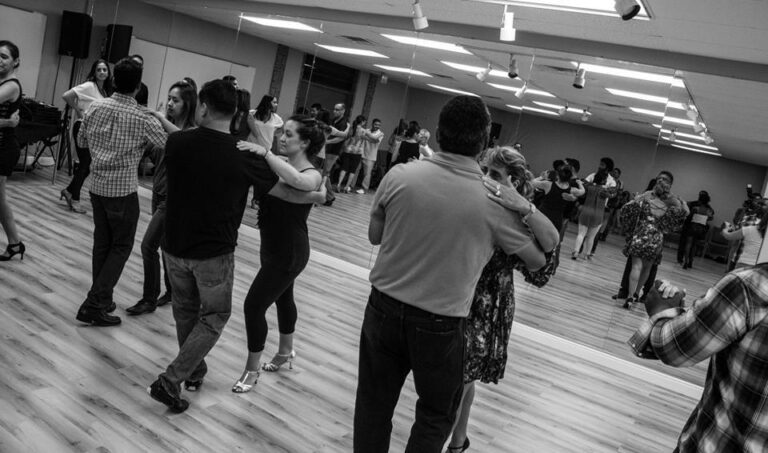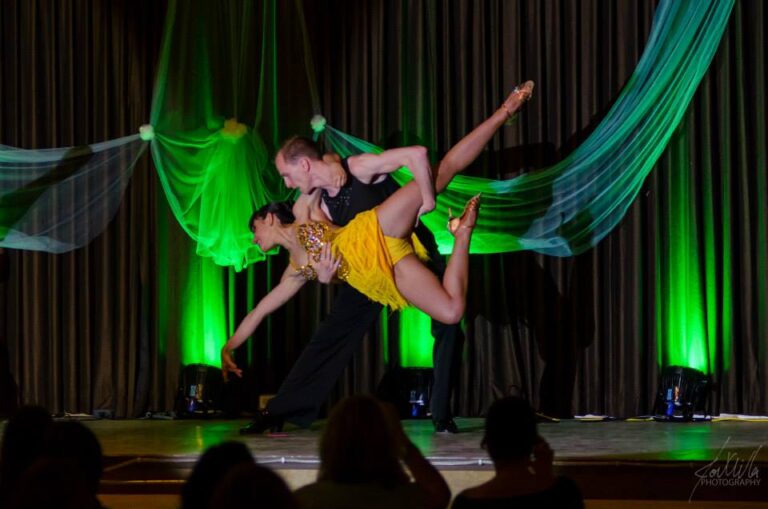Social dancing as a way of meeting romantic partners
Partnered dancing is a relatively recent development, as these things go. That said, group dances have long been a way for men and women in cultures all over the world to socialize and display their attractive features.
“In Congo we have dances in which the men are in the middle of a big circle, showing off for the women,” explains Lam LaKiz. “Like peacocks, trying to impress!”
With the rise of couple dancing, potential partners were presented with more opportunities to interact directly. Think of the Russian court dances in Anna Karenina, or the society events represented in Downton Abbey. Debutante balls were (are) all about young ladies being presented to eligible young men. Square dances and reels could easily be likened to speed dating. These days there is plenty of talk of “meat markets” and “hook-up culture” when it comes to bars and clubs: dancing to find sexual relationships that might afterwards turn romantic.
 In our couple dance communities, we sometimes try to hold ourselves apart from that. Certainly some people really do come out for pure love of the dance, to become more active, or just to make friends. Still, “meeting girls” or guys remains one of the most important reasons people start social dancing. Ask around, or even check the bios of your favorite artists – an amazing number of them didn’t start off dreaming of going pro, they just wanted a significant other.
In our couple dance communities, we sometimes try to hold ourselves apart from that. Certainly some people really do come out for pure love of the dance, to become more active, or just to make friends. Still, “meeting girls” or guys remains one of the most important reasons people start social dancing. Ask around, or even check the bios of your favorite artists – an amazing number of them didn’t start off dreaming of going pro, they just wanted a significant other.
Advantages to looking for love in the dance scene
Depending where you live, the dance scene can offer a relatively large pool of people; more than a sports team or cooking class, for example. You can meet a lot of people in quite a short period of time. That’s especially true if you’re not wedded to just one style.
Dancing offers the chance to engage in structured, short-term interactions, so there’s not too much to deal with up front. Certainly asking someone to dance is much less intimidating than striking up a conversation in a book store. Once your interest is piqued, you can ask for another dance later, or even have a brief conversation while getting some water. You can ask if they’ll be at the next dance, confirming an opportunity to see them again without fearing rejection.
When you are in the same dance community, you can see how a potential love interest treats other people, and how others respond to them. You get a sense of how they communicate, not only verbally but also in their dancing. Are they courteous, kind, confident or funny? Do they hog all the attention, or do they let you have a voice? Are they aggressive or gentle, helpful or rushed? So much of someone’s personality translates into movement on the dance floor.
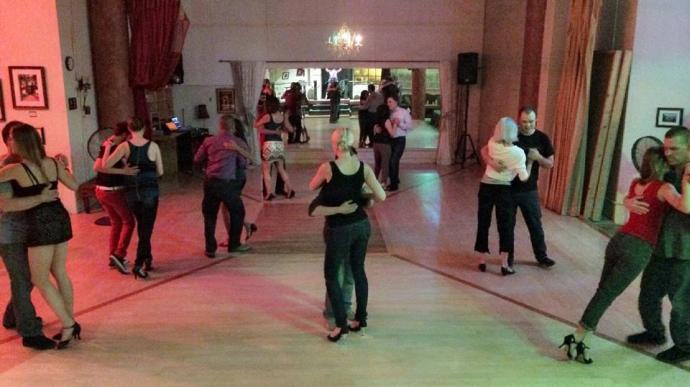
An obvious advantage is the chance to check physical compatibility. In open position dances, you do have the proximity to get a whiff of their activity-induced sweat. Pheromones are still a factor in attraction among human beings, however evolved we’d like to think we are! In close connection dances, you are in fact embracing your partner and can easily sense how you fit together.
Plus, if you do start dating someone in the dance scene, there are still more advantages. You already have a shared passion and an activity that takes you out together. You may also gain a practice partner, carpool buddy, and someone to share the costs of hotel stays at dance festivals. Not to mention that it’ll be easy to keep hanging out with your single friends!
Special challenges of dating in the dance scene
You’re probably already sighing, thinking of a horror story from your own or a friend’s experience. This is not an easy proposition, for several very different reasons, some of which you may never have considered. Have you ever thought about how tough it is for anyone in the dance scene who is not heterosexual or on a clear side of the gender binary, for example?
Let’s start by saying you need to be careful about exploring your attraction. Ideally, dance venues should be safe spaces. People need to believe that they are not going to be molested or hurt while engaging in these close contact activities. Unfortunately, nearly every female dancer and quite a lot of men have experienced unwanted intimate contact at a dance. So, don’t be the creeper that rubs on your partner, caresses inappropriately, or presses close in the groin area. I’m not saying we can never heat things up a little on the dance floor, but it should really only be with someone who has already confirmed interest in you. Furthermore, if you want to take things up a notch, go slowly (slight shoulder rub, small lean) and make sure that you’re getting consent along the way. Don’t wait for someone to get up the guts to cause a conflict by telling you to back off. Make sure that you are hearing an enthusiastic “YES” in every fiber of their being, or go back to purely socially appropriate contact. RESPECT is key.
(Not sure about this consent stuff? Check out some great resources here and here.)
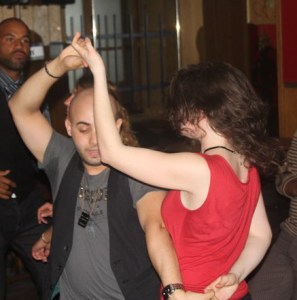
Sometimes it can seem too risky to try to develop a romantic attachment within the dance scene. If everything is going well as it is, why change something and risk messing it all up? Kylie, a dancer in Sydney, shares: “Dancing is very free and joyful for me; it’s an escape. I didn’t want to complicate that with a lot of emotion in what is a close community.”
The next big challenge is managing your privacy. Sometimes in the dance scene it can feel like you’re living in public. It seems like everyone notices when you start spending more time with someone in particular, and people might start asking you questions about your relationship before you’re even sure how to define it yourself. If you’re a private person, used to keeping different aspects of your life as compartmentalized as possible, this may seem an impossible hurdle. Often we respond by keeping a new relationship secret. We text and Facebook chat to avoid being seen making plans together, and leave separately even though we’re going to hang out afterward. This sort of subterfuge is perfectly natural and can help preserve your privacy while you’re exploring a new relationship. Once you are willing to commit to something together, though, that should probably change. If you still feel the need to keep it secret after months together, that might be a red flag. That’s particularly true if only one of you is pushing for that, just as it would be outside the dance scene.
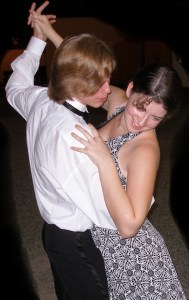 Jealousy is also an issue for us dancers. It can be hard to trust your partner, as you watch them dancing “promiscuously” with a wide variety of partners, some of whom may be intimidating in their own attractive qualities. In dances that are more exhibitionist, such as salsa, you may watch and wonder if your partner prefers a stronger dancer. For close contact dances, it can be hard for your partner to accept gracefully that you enjoy being snuggled up to another. On top of that, some people may be afraid to ask you to dance when your significant other is nearby, not necessarily because they have inappropriate intent, but simply because they aren’t sure how it will be perceived.
Jealousy is also an issue for us dancers. It can be hard to trust your partner, as you watch them dancing “promiscuously” with a wide variety of partners, some of whom may be intimidating in their own attractive qualities. In dances that are more exhibitionist, such as salsa, you may watch and wonder if your partner prefers a stronger dancer. For close contact dances, it can be hard for your partner to accept gracefully that you enjoy being snuggled up to another. On top of that, some people may be afraid to ask you to dance when your significant other is nearby, not necessarily because they have inappropriate intent, but simply because they aren’t sure how it will be perceived.
Finally, as if breakups weren’t hard enough already, if your dance-inspired romance doesn’t last, there are some difficult consequences. People are undoubtedly going to be curious, endlessly asking if you’re still together, what went wrong, how you’re feeling…some of them out of genuine concern for your happiness, but most from that unfortunate human glee in gossip. Each time you come to a dance, there will be some people who still haven’t heard, and you’ll have to face the questions once again. If it was a particularly bad split, you may also have to choose between seeing your ex on a regular basis and leaving the scene.
Keys to making it work
Let’s start with some advice your parents might give you: don’t rush in. Especially since, as we’ve noted, it could be hard to rush out. Pay attention to be sure you have a basis for a relationship beyond physical attraction or star worship. Are you really compatible? How quickly do they go through significant others? Are you genuinely interested in them or are you just lonely?
 Try not to view others in the dance scene as competitors for the object of your affection. I have more personal experience with this kind of negativity among ladies. We lose so much energy to rivalry when we should be supporting and encouraging one another to maintain healthy relationships.
Try not to view others in the dance scene as competitors for the object of your affection. I have more personal experience with this kind of negativity among ladies. We lose so much energy to rivalry when we should be supporting and encouraging one another to maintain healthy relationships.
Most importantly, communicate clearly with your love interest. Let them know that you’re interested. Tell them how you feel and how you are feeling. Be honest with yourself about your own insecurities, and don’t blame them on others. Avoiding jealous conflict comes down to believing that your partner is truly into you, and trusting them to be faithful. Listen to your dear one and support their growth as an individual.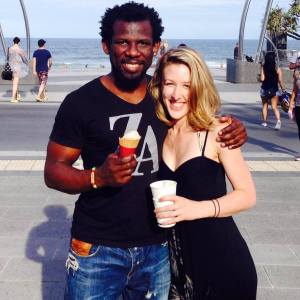
Make sure your relationship exists outside the dance scene. Have date night regularly somewhere other than the weekly social. Find activities you enjoy together and invest quality time in each other. Introduce them to your non-dancing friends and see what the reactions are.
Lastly and above all, remember respect. Respect each person’s right to feel safe and enjoy themselves at a dance. Respect the person who rejects you. Avoid asking bothersome questions about others’ relationships unless you are really close. Respect your own worth.
Special thanks to Lam LaKiz and Kylie for their contributions to this article, both visual and verbal!
